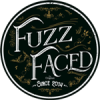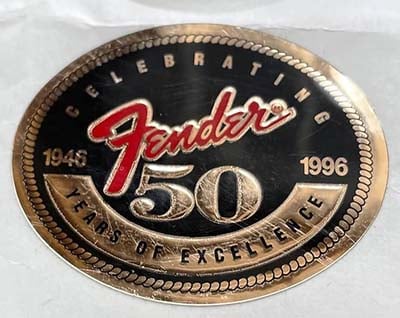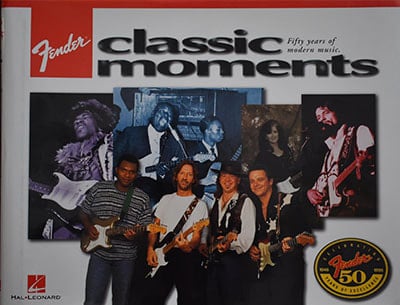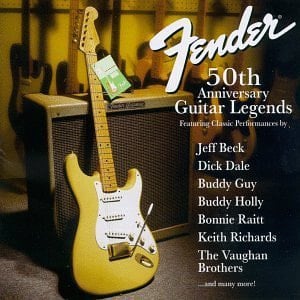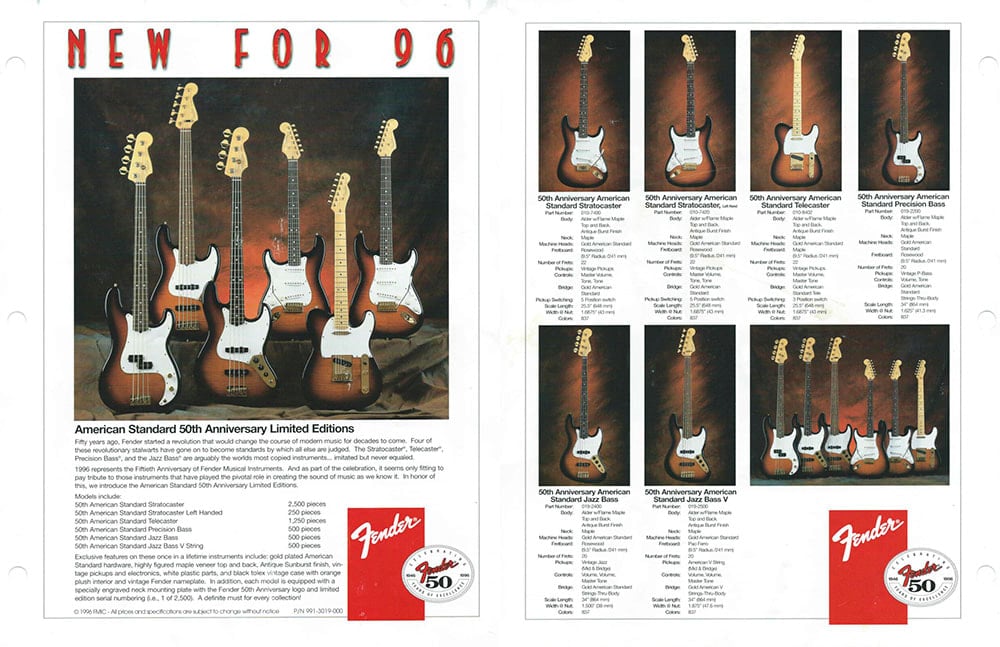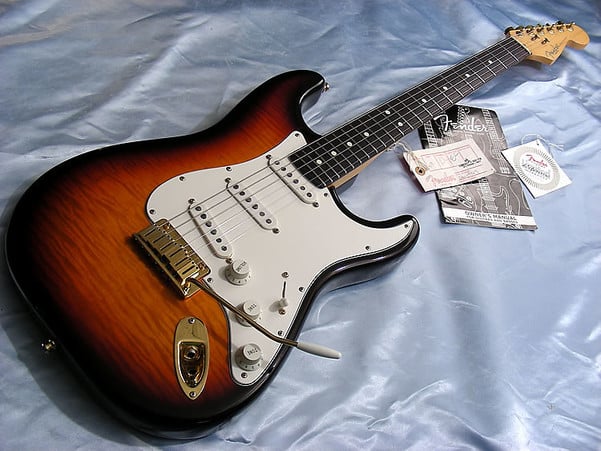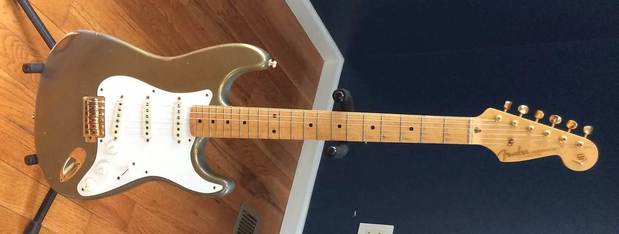In 1996 Fender celebrated its 50th Anniversary with an article by Richard Smith that appeared in the 1996 Winter issue of the Frontline magazine about the birth in 1946 of the Fender Manufacturing Company, which soon became Fender Electric Instrument Company.
|
Furthermore, Hal Leonard released the book Fender Classic Moments. Fender instruments had a profound impact on popular music in the latter half of the 20th century. In turn, the continuing development of Fender guitars, basses, and amps had been shaped by many gifted artists who have made Fender a part of their own personal styles. That's what Fender Classic Moments was all about — the unique relationship that exists between the artist, instrument, and audience. The book featured over 100 photos and lively text chronicling great guitar moments and history-changing happenings.
|
The history of the Fender guitar in the latter half of the 20th century and its role in popular music history was documented also on the CD Fender 50th Anniversary Guitar Legends collection released by Virgin Records in 1996 featuring such Fender-powered hits as Deep Purple's “Smoke on the Water,” Buddy Holly's “That'll Be the Day,” Dire Straits' “Sultans of Swing,” Jimi Hendrix's “Spanish Castle Magic,” Nirvana's “Come as You Are,” and Dick Dale's “Misirlou.”
50TH ANNIVERSARY MODELS
All factory-built instruments produced throughout 1996 gained a commemorative sticker bearing the words “Fender 1946-1996 50 Years of Excellence” applied on the back of the headstock. These regular production guitars should not be confused with the official anniversary models released by Fender in the same year.
To celebrate its 50 years, Fender released a whole line of special American Standard instruments with gold-plated hardware. The 50th Anniversary American Standard Stratocaster was produced as a limited edition model with only 2500 units shipped. Each guitar was serialized in the form of S0001 of S2500 on the commemorative neck plate.
Over the years, rumors have circulated concerning the precise origin of the 50th Anniversary American Standard Stratocaster. It has been suggested by some (including a few enthusiastic sellers) that its attractive alder body with figured maple veneered top and back, finished in Antique Burst, was crafted by, or made with the assistance of some Custom Shop luthier in 1996, but there is no evidence to that and reality is simply that this guitar was crafted in the Fender factory in 1996.
Other features included vintage-style pickups, a 2-point tremolo bridge, and a rosewood fingerboard.
As Fender did with all the other sunburst-finished American Standard Stratocaster throughout the ‘90s, the back contour was completely painted in black to hide the veneered back.
Other features included vintage-style pickups, a 2-point tremolo bridge, and a rosewood fingerboard.
As Fender did with all the other sunburst-finished American Standard Stratocaster throughout the ‘90s, the back contour was completely painted in black to hide the veneered back.
A 1996 50th anniversary Stratocaster. A commemorarive sticker was applied on the pickguard of the pickguard of the 50th Anniversary American Standard Series instruments, but usually it was removed and lost by guitarists.
The same year the Custom Shop produced a limited edition run of 200 50th Anniversary Relic Stratocaster, a 1956 reissue with an alder body in Aztec Gold finish aged by Vince Cunetto.
This guitar featured a soft “V” shape high-grade bird’s eye one-piece neck with a modern 9.5” radius, and aged gold hardware.
The 50th Anniversary Relic Stratocaster was serialized in the style of 001 of 200, and the number was actually stamped into the wood on the back face of the headstock.
As with other Diamond Dealer models, only the instruments sold in the home market carried the diamond inlaid Custom Shop V logo on the ball of the headstock.
This guitar featured a soft “V” shape high-grade bird’s eye one-piece neck with a modern 9.5” radius, and aged gold hardware.
The 50th Anniversary Relic Stratocaster was serialized in the style of 001 of 200, and the number was actually stamped into the wood on the back face of the headstock.
As with other Diamond Dealer models, only the instruments sold in the home market carried the diamond inlaid Custom Shop V logo on the ball of the headstock.
Antonio Calvosa
MAIN SOURCES
- Anniversary Strat by Gary Davies
- Fender Frontlines and catalogs
- Guitars inspection and photos
- Special thanks to Vince CunettO
- Anniversary Strat by Gary Davies
- Fender Frontlines and catalogs
- Guitars inspection and photos
- Special thanks to Vince CunettO
